
| ‘Pearls’ – this word instantly creates an image of a white, smooth, lustrous and round gemstone. Officially the world’s oldest gemstone, dating back to earlier than 420 BC, is also known as the ‘Queen of Gems’. In addition to enhancing the beauty of the wearer, pearls also impart valuable spiritual benefits. However, the spiritual benefits depend on the sattvikata (Spiritual purity) of the pearls or the pearl jewellery. If they are not sattvik, they will not be spiritually beneficial and may be detrimental too.
Gemologists have developed elaborate standard-isation scales such as the GIA Pearl grading scale based on 7 Pearl Value Factors – Size, Shape, Colour, Nacre, Lustre, Surface and Matching. This helps the customer decide the material value of the pearls he is buying. However, where do these Pearl Value Factors stand from the spiritual persective ? By understanding the associated spiritual science, you can invest in or gift pure, sattvik pearls and pearl jewellery to your loved ones so as to obtain the highest possible spiritual benefit from it. |
1. Associated Cosmic Principles
Pearls are associated with the Absolute Water and Fire Principles.
2. Importance as per astrology
2A. Pearls are associated with the Chandra (Moon)graha (Note). Upon wearing pearls, the cool spiritual vibrations being emitting from the Moon are attracted to them and then to the wearer’s mind. This imparts serenity to the wearer.
Note : Here the word ‘Graha’ is used as per astrology, not astronomy. Please refer to ‘Point 3. Wearing gems to avoid ‘grahadosh’ was mentioned in our earlier articles.
2B. As per astrology, when people are advised to wear gemstones, they are mostly worn embedded in rings. However, in the case of pearls, the wearer can obtain spiritual benefits to an even greater extent when they are worn in the form of a necklace extending upto the Anahat-chakra (Heart-chakra). The Anahat-chakra is associated with emotions and spiritual emotion (Emotion for God). As the graha ‘Moon’ is also associated with emotions, when pearls touch the Anahat-chakra, the cool and calm waves of the Moon imbibed by the pearls provide serenity to the wearer’s mind.
2C. If a pearl is embedded in gold or silver jewellery, it benefits the wearer with the Principles of the grahas Sun and Moon respectively and provide higher spiritual benefits.
2D. Since Moon has a benevolent relationship with the Sun, Mars and Venus grahas, it can be worn with the gemstones associated with these grahas – ruby, coral and diamond respectively. When worn with these gems, their vibrations complement each other and benefit the wearer even more at the spiritual level.
3. Types of pearls
3A. Natural pearls : Pearls are produced by certain molluscs when some irritants such as a microscopic organism accidentally enter their body. As a defense mechanism, the mollusc secretes many layers of natural minerals (primarily calcium carbonate) and proteins, known as ‘Nacre’ (pronounced NAY-ker). Owing to this Nacre, pearls get their beautiful lustre and colours. Natural pearls come in two varieties.
 3A 1. Nacreous pearls : When a mollusc secretes nacre around an irritant and forms a pearl, it is known as a ‘Nacreous Pearl’. Nacre decides the durability, popularity and the market value of pearls. Nacre is also important from the spiritual perspective as it has the ability to attract and emit sattvikata of the Moon graha and Chaitanya (Divine consciousness). Hence, the thicker and more beautiful the nacre, the more beautiful, sattvik and spiritually beneficial the pearl.
3A 1. Nacreous pearls : When a mollusc secretes nacre around an irritant and forms a pearl, it is known as a ‘Nacreous Pearl’. Nacre decides the durability, popularity and the market value of pearls. Nacre is also important from the spiritual perspective as it has the ability to attract and emit sattvikata of the Moon graha and Chaitanya (Divine consciousness). Hence, the thicker and more beautiful the nacre, the more beautiful, sattvik and spiritually beneficial the pearl.
3A 2. Non-nacreous pearls : There is another variety – ‘Non-nacreous Pearls’. These are produced by snails that do not secrete nacre. This is why, these are not considered to be ‘true pearls’. Examples are Melo Melo pearls and Conch pearls.
 3A 2A. Melo Melo pearls : These are produced by a large sea snail called ‘Melo Melo’ found in South China Sea and a few other places. They are composed of calcite and aragonite and have a porcelaneous texture. Their large size and exclusive colours like orange to brown make them exotic and highly sought after. ‘Melo Melo’ pearls are extremely rare as they are formed by 1 snail among thousands and can take decades to grow. Hence, they are very expensive, costing upto Rupees 55 lakhs per pearl.
3A 2A. Melo Melo pearls : These are produced by a large sea snail called ‘Melo Melo’ found in South China Sea and a few other places. They are composed of calcite and aragonite and have a porcelaneous texture. Their large size and exclusive colours like orange to brown make them exotic and highly sought after. ‘Melo Melo’ pearls are extremely rare as they are formed by 1 snail among thousands and can take decades to grow. Hence, they are very expensive, costing upto Rupees 55 lakhs per pearl.
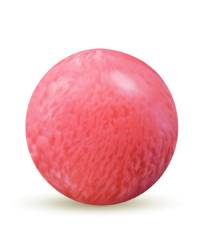 3A 2B. Conch pearls : These are produced by the Queen Conch (pronounced ‘conk’) mollusc, a large, edible sea snail, primarily found in the Caribbean. These are most often pink, oval-shaped and have a creamy, porcelain-like appearance like ‘Melo Melo’ pearls. However, Conch Pearls exhibit a wave-like ‘flame’ structure on their surface. Since these are among the rarest, these are also the most expensive type. A top-grade Conch pearl can cost about Rupees 3 to 5 lakh per carat.
3A 2B. Conch pearls : These are produced by the Queen Conch (pronounced ‘conk’) mollusc, a large, edible sea snail, primarily found in the Caribbean. These are most often pink, oval-shaped and have a creamy, porcelain-like appearance like ‘Melo Melo’ pearls. However, Conch Pearls exhibit a wave-like ‘flame’ structure on their surface. Since these are among the rarest, these are also the most expensive type. A top-grade Conch pearl can cost about Rupees 3 to 5 lakh per carat.
3A 3. Spiritual efficacy of natural pearls : Across spiritual variables such as proportion of sattvikata, spiritual efficacy, ability to imbibe and emit Chaitanya, possibility of control by subtle negative energies and the proportion of protective sheath of Moon graha Principle around wearer, the nacreous pearls are far better than the non-nacreous ones.
3B. Cultured pearls : Cultured pearls are also real pearls, except that an irritant is deliberately implanted by man into the mollusc. These irritants vary in size and shape, according to the industrial demand. The pearls tend to follow the shape of the inserted material. Hence, they come in various shapes and colours with different hues and overtones. These shades and colours are obtained from the iridescent nacre that the mollusc secretes when the irritant is introduced during culturing. Most pearls sold today are cultured. Depending on the species of mollusc and whether it is grown in freshwater or saltwater, there are 4 types of popularly cultured pearls – South Sea, Akoya, Freshwater and Tahitian.
 3B 1. South Sea cultured pearls : As the name suggests, the South Sea pearls are primarily cul-tured in the saltwaters off the coasts of Australia, Indonesia and the Philippines. They come in white, silver or golden hues, depending on the type of oyster species they are cultured in.South Sea pearls are characterised by relatively large size and thick nacre, which enhance their beauty and durability.
3B 1. South Sea cultured pearls : As the name suggests, the South Sea pearls are primarily cul-tured in the saltwaters off the coasts of Australia, Indonesia and the Philippines. They come in white, silver or golden hues, depending on the type of oyster species they are cultured in.South Sea pearls are characterised by relatively large size and thick nacre, which enhance their beauty and durability.
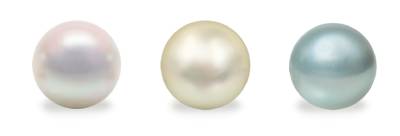 3B 2. Akoya cultured pearls : The name ‘Akoya’ is given to the pearls that are produced in saltwater by the Japanese Akoya oysters. Primarily culti-vated in the ocean around Japan and China, these are the most familiar kind of pearls. These are known for their beautiful white or cream colour, lustre and almost perfect round shape. Classic pieces of pearl jewellery are generally made using Akoya pearls.
3B 2. Akoya cultured pearls : The name ‘Akoya’ is given to the pearls that are produced in saltwater by the Japanese Akoya oysters. Primarily culti-vated in the ocean around Japan and China, these are the most familiar kind of pearls. These are known for their beautiful white or cream colour, lustre and almost perfect round shape. Classic pieces of pearl jewellery are generally made using Akoya pearls.
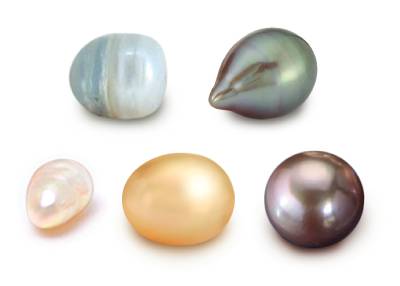 3B 3. Freshwater cultured pearls : Most common and popular among pearl enthusiasts including shoppers and jewellery designers, freshwater pearls, are cultured in freshwater lakes and ponds. Since these are easy to culture and harvest, these are produced in various sizes, shapes and colours. Since several pearls can be grown in a single oyster, these are commercially available at a lower price. China produces most of the freshwater pearls.
3B 3. Freshwater cultured pearls : Most common and popular among pearl enthusiasts including shoppers and jewellery designers, freshwater pearls, are cultured in freshwater lakes and ponds. Since these are easy to culture and harvest, these are produced in various sizes, shapes and colours. Since several pearls can be grown in a single oyster, these are commercially available at a lower price. China produces most of the freshwater pearls.
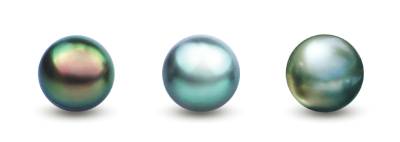 3B 4. Tahitian cultured pearls : Another popular type of saltwater pearls, Tahitian pearls, are primarily cultivated around the islands of French Polynesia, most familiar of these being Tahiti. Owing to their dark colour such as black, grey or brown with blue, green, purple or pink overtones, Tahitian pearls are considered exotic and are hence sought after.
3B 4. Tahitian cultured pearls : Another popular type of saltwater pearls, Tahitian pearls, are primarily cultivated around the islands of French Polynesia, most familiar of these being Tahiti. Owing to their dark colour such as black, grey or brown with blue, green, purple or pink overtones, Tahitian pearls are considered exotic and are hence sought after.
3B 5. Spiritual efficacy of cultured pearls : Across spiritual variables such as proportion of sattvikata, spiritual efficacy, ability to imbibe and emit Chaitanya, possibility of control by subtle negative energies and proportion of protective sheath of Moon graha Principle around wearer, the South Sea pearls are the most sattvik followed by the Akoya, Freshwater and Tahitian pearls.
3C. Imitation pearls : Imitation pearls are not real pearls since these are primarily glass beads dipped into a solution made from fish scales.
The coating on these pearls is thin and temporary and it tends to wear off. One aspect that defines imitation pearls is that these are smooth when rubbed against the teeth, while natural or cultured pearls are slightly rough.
The island of Mallorca (Majorca) in Spain is known for its imitation pearl industry. Imitation pearls are frequently called ‘Mallorca pearls’ or ‘Majorca pearls’.
Having understood some physical aspects of the 3 broad categories of pearls, how they fare across various spiritual aspects is explained in the following table.
Note 1 : Natural pearls have a higher ability to imbibe and emit sattvikata. Hence, their spiritual efficacy is more. However, the efficacy also depends on the colour, lustre, smoothness and shape of the pearls.
Note 2 : Since imitation pearls are high in Raja-Tama components, they attract distressing vibrations in the environment to a greater extent. This is why, these are detrimental.
| Spiritual aspects | Natural pearls | Cultured pearls | Imitation pearls |
| 1. Predominant active Cosmic Principle 2. Ability to imbibe Moon graha Principle (%) |
Fire and Water 11 to 20 |
Water and Fire 2 to 3 |
Earth and Water 0 |
| 3. Ability to emit Moon graha Principle (%) | 15 to 25 | 3 to 5 | 0 |
| 4. Predominant Triguna emitted | Sattva-Raja | Raja-Sattva or Raja | Raja-Tama or Tama |
| 5. Spiritual efficacy (Note 1) | High | Medium | Low |
| 6. Proportion of control on gemstones by subtle negative energies | Very low | Medium | High |
| 7. Nature and proportion of effect on wearer | High positive benefit | Low positive benefit | Detrimental to a certain extent (Note 2) |
4. Colour of pearls
Pearls are available in various colours, with different body overtones and shades, depending on the water source and animal species. Most popular ones are white, black, grey (or charcoal), yellow, orange, pink, lavender, green and blue. Since natural black and charcoal-colour pearls are rarely found, these are preferred by buyers. Even freshwater pearls are dyed to get a black tinge to imitate Tahitian pearls and to make them more readily available to the buyers.
The white pearls emit Sattva component and Tejtattva. Hence, the wearer obtains maximum spiritual benefit. These provide serenity to the mind and create a protective covering around the wearer. In contrast, though black pearls are attractive from the sales perspective, from a spiritual perspective they are the most detrimental among all the 9 colours mentioned earlier. This is because they are Tama-Raja predominant, and hence, can cause distress to the wearer in the form of negative thoughts and a distressing covering around the wearer.
4A. Spiritual efficacy : From the perspective of spiritual benefits, the various pearl colours in descending order of benefit are – white, golden, silvery, yellow, pink, orange, blue, bronze, lavender, purple, green, grey and black. Pearl colours from orange to bronze have some beneficial effect; those lower in the order are actually detrimental, with black being the most detrimental of all.
5. Shapes of pearls

Pearls can be formed in various shapes depending upon the shape of the irritant or material that is inserted during culturing. This can lead to round, symmetrical and asymmetrical shapes. The most popular shape of pearls is round. However, the other shapes such as near-round, button, drop, oval, semi-baroque and baroque are quite sought after due to their uniqueness. Baroque and semi-baroque are asymmetrical and are mostly cultured in freshwater.
Examples of other unique shaped pearls are Coin pearls (flat), Mabe pearls (hemispherical), Heart-shaped pearls, Rice pearls etc.
5A. Spiritual efficacy : From the spiritual perspective, the round shape attracts and emits the Deity Principle to the maximum (other factors such as colour, size etc. adding to it). This is followed by near-round, oval, button and drop shapes. The asymmetrical shapes can be spiritually detrimental to the wearer.
6. Size of pearls
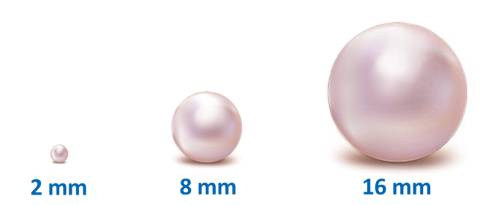
Pearls are formed in different sizes ranging from 2-16 mm in diameter, majority of them being under 10 mm. Larger pearls are rare and their value is dependent on their size – the bigger they are the more valuable (all other value factors being equal).
6A. Spiritual efficacy : From the spiritual perspective, medium size pearls ranging from 7-11 mm in diameter (medium size) are the most beneficial spiritually. These create the maximum protective sheath of Moon graha Principle around the wearer and the positive effect lasts a few days. The next best are the pearls in the small size, ranging from 2-6 mm in diameter. Their beneficial effect lasts a few hours. The beneficial effect of the large sized pearls (12-16 mm in diameter) lasts a few minutes only.
7. Cosmetic and therapeutic uses of pearls
As natural and cultured pearls undergo a long journey before being sold as gems, it is natural that not all will be able to pass the quality grading process. This can be due to several blemishes or irregularities or other factors owing to which their market value may have been degraded. Such ‘Flawed pearls’ are, however, used for other purposes such as in beauty products and medicines. When pearls are utilised in this manner, the consumer nevertheless benefits at the physical and subtle levels.
Pearl is predominant in Apatattva. Hence, when it is consumed as a medicine, it is easily digested and absorbed in the blood. The cool spiritual waves emanating from the pearl spread in the body and reduce the heat in it. The wear and tear of cells is repaired. A small fraction of the Moon graha Principle present in the pearl removes the harmful effects of toxins and rejuvenates the body. As a result, the body becomes healthy and radiant. Even the distressing covering around the mind reduces, and the mind becomes sattvik and positive. Hence, the consumer benefits from the medicines made from pearls at the physical, mental and spiritual levels.
Thus, we can see that pearls are much more than a mere fashion statement. If we carefully consider the various factors that decide the sattvikata of pearls, we can strike a judicious balance between elegance, investment and spiritual benefit.
– Paratpar Guru (Dr.) Athavale (Founder, Maharshi Adhyatma Vishwavidyalay) and Dr. (Mrs.) Nandini Samant (Member of research team, Maharshi Adhyatma Vishwavidyalay, Goa.)
E-mail : [email protected]
For additional information, contact : 9561574972
Maharshi Adhyatma Vishwavidyalay :
|

 Delhi HC slams ‘Google’ while issuing the notice
Delhi HC slams ‘Google’ while issuing the notice I have never seen a court as undisciplined as the Supreme Court !
I have never seen a court as undisciplined as the Supreme Court ! A powerful 7.1 magnitude earthquake hit the Tibet region
A powerful 7.1 magnitude earthquake hit the Tibet region Two satellites will dock in space on January 7th
Two satellites will dock in space on January 7th Scientific research conducted by Maharshi Adhyatma Vishwavidyalay using the Universal Aura Scanner (UAS) to study the spiritual effect on the river water after Saints have taken the ‘Rajayogi (Royal) Bath’ on the occasion of Kumbh mela
Scientific research conducted by Maharshi Adhyatma Vishwavidyalay using the Universal Aura Scanner (UAS) to study the spiritual effect on the river water after Saints have taken the ‘Rajayogi (Royal) Bath’ on the occasion of Kumbh mela Can Our Collective Consciousness Mitigate Climate Change ?
Can Our Collective Consciousness Mitigate Climate Change ?